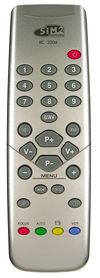SIM2 RTX-45 DLP HD Monitor Page 2
 Regardless of how you use the display, you'll find that it produces an excellent picture. For starters, black levels are stable, which is to be expected from a solid-state display, and they're also fairly dark, which isn't quite as common for a fixed-pixel device. In fact, the image's contrast was very good, in large part because the picture is extremely bright. In the graphics gamma mode, the picture can get as bright as 175 foot-lamberts before it starts to crush near-white details. Granted, the screen isn't huge, but that's a lot of light. According to SMPTE, a light placed behind the monitor to help bias your eye against the ever-changing TV image should have an output level of approximately 40 percent of the display's peak brightness. To put that into perspective, a bias light for this display would be brighter than most direct-view televisions. Of the gamma settings, the film setting is most accurate for video sources, regardless of whether or not the source originated on film. The video setting, ironically enough, seems to be more accurate for computer displays, while the graphics mode seems like an enhancement. SIM2 suggests that it might be good for video games.
Regardless of how you use the display, you'll find that it produces an excellent picture. For starters, black levels are stable, which is to be expected from a solid-state display, and they're also fairly dark, which isn't quite as common for a fixed-pixel device. In fact, the image's contrast was very good, in large part because the picture is extremely bright. In the graphics gamma mode, the picture can get as bright as 175 foot-lamberts before it starts to crush near-white details. Granted, the screen isn't huge, but that's a lot of light. According to SMPTE, a light placed behind the monitor to help bias your eye against the ever-changing TV image should have an output level of approximately 40 percent of the display's peak brightness. To put that into perspective, a bias light for this display would be brighter than most direct-view televisions. Of the gamma settings, the film setting is most accurate for video sources, regardless of whether or not the source originated on film. The video setting, ironically enough, seems to be more accurate for computer displays, while the graphics mode seems like an enhancement. SIM2 suggests that it might be good for video games.
You might think that the RTX-45's abundant light output comes with sacrifices in other areas. So far, we haven't found any. Geometry patterns look excellent but, more importantly, show that the set has little or no overscan. This means that you see the entire picture from edge to edge. Most TVs hide approximately 5 percent of the image's edge behind a bezel to make sure the image fills the screen. Also, the set's accurate color decoder feeds the display's color-filter wheel, which uses fairly accurate primary colors (see the measurements chart). They're richer than those of a similarly priced plasma display and make for a vibrant picture. Our sample, which had been used for more than a few dealer demos, did lean a bit toward the bluish-green side before color-balance calibration. Regardless of whether or not this is typical, I'd highly recommend a professional calibration. The outcome is excellent (again, see the measurements chart), and the resulting picture is outstanding.
The display excels in other areas, as well. The onboard video processing, courtesy of Faroudja, provides 3:2 film-sequence detection to prevent motion artifacts when it deinterlaces video images. A Pixel Works–based scaler does an excellent job of matching the incoming signal to the display's native 720p resolution. If you have a native 720p source, you can use the pixel-for-pixel aspect-ratio setting and bypass the processor altogether. Speaking of aspect ratios, the set includes more than you'll need; and, unlike with many displays these days, you can access them with both interlaced and progressive sources.
The RTX-45's drawbacks are few and far between and might only include fan noise and lack of space for a center-channel speaker on top. The outboard box produces the most noise, but you can hide it. The display produces no more noise than a typical plasma display or DLP front projector but more noise than your average CRT-based rear-projection TV. The cabinet style just doesn't lend itself to placing a big, boxy center speaker on top, which is inconvenient but not disastrous. An optional shelf would be nice.
With a price tag of $10,995, the RTX-45 costs more than the typical rear-projection display, particularly one with this screen size. The set is definitely better than any of the existing rear-projection DLP displays that we've seen, although again it's also more expensive than some recent models. Performance does come with a price. The display's most likely competition, given its small footprint and svelte design, is plasma displays. From a performance standpoint, comparing the RTX-45 with a plasma display is like sandblasting a soup cracker; the RTX-45 would win hands down. You just can't easily mount it above a fireplace. The SIM2 display's coolest aspects are its outboard box and fiberoptic connection. The fiberoptic cable is far less expensive and easier to pull through a wall or snake along the molding than a DVI cable. Yet, it stills provides a digital connection between the units. Display technology will undoubtedly improve over the next 10 to 20 years, but the RTX-45 display will likely still offer a competitive picture. DLP's lack of phosphor burn and ease of bulb replacement make it a good candidate for long-term use. Connection standards may change more rapidly; however, with this system, you can just replace the outboard box when you need to. That, in and of itself, makes the RTX-45 worth considering.
 Highlights
Highlights
• Great picture in a small form factor
• Neat fiberoptic link to the equipment
- Log in or register to post comments

























































